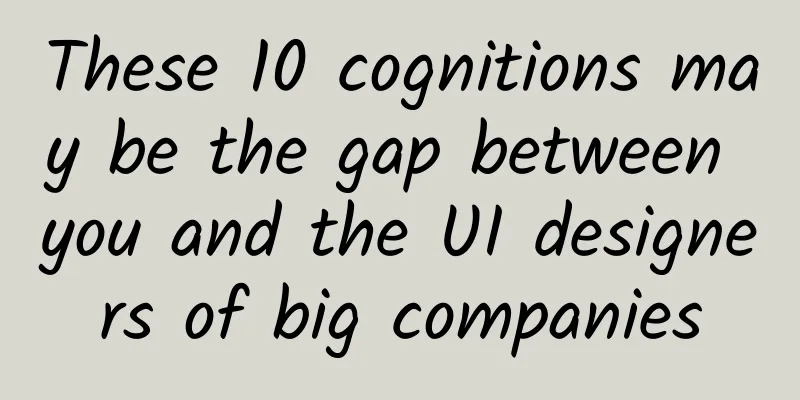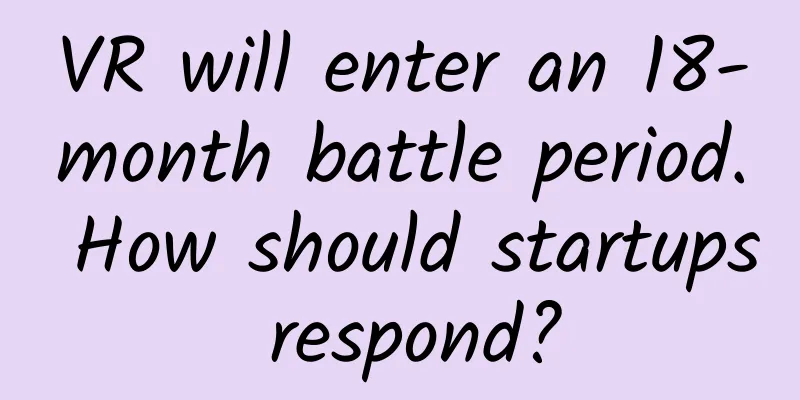These 10 cognitions may be the gap between you and the UI designers of big companies

|
As UI design continues to gain popularity, although it is no longer as difficult to find talent as in previous years, there are still many people who want to switch to the UI design industry. On one hand, there is a constant influx of passionate young people who hope to join this industry; on the other hand, there are those who struggle in the industry and hope to constantly break through themselves. Faced with this multifaceted situation, have you ever reflected on yourself? Given your current environment and your own professional abilities, are you really capable of UI design? Many UI designers are still at the stage of prototype porters, and even many designers still think that UI design is a condensed version of poster design, which is just drawing pictures and arranging layouts, and there is no technical difficulty. Only by deepening this industry can you understand this cognition. If you just stay at this cognition, then you may need to re-establish your cognition of UI designers. The following is my personal opinion on UI design, hoping to help designers who are new to the industry and help them clearly understand the responsibilities of UI designers and how to complete their future advancement step by step. My opinion is my personal view, and I hope you can leave a message to correct me and help more designers. Share Directory
1. UI design is not material synthesis For designers who have just entered the workplace, we must improve our project participation and design execution capabilities in the shortest possible time. Many designers' first reaction when receiving a project is to look for materials, especially in icon design, and they are accustomed to downloading materials and using them directly. This will not only reduce the quality of the design draft, but also continuously lose the ability to execute. We need to customize the components of the interface according to different projects rather than synthesizing materials. Even if it is a simple and common icon, we have to draw it ourselves in the original style. This not only maintains the unity of the style of the entire work, but also enhances our design execution capabilities and software operation proficiency. 2. UI design is not art painting With the impact of many concept designs nowadays, many designers often see a lot of cool UI design works on foreign design platforms such as Dribbble and Behance, but you should not think that this is the result of your daily work project. In real projects, UI design is not art painting. While we are seeking sensory experience, overall thinking such as product thinking, interaction logic, brand genes, emotional elements, etc. is also very important. When it comes to painting, another question comes up: do UI designers need hand-drawing skills? Many designers have discussed this issue before. Of course, designers with hand-drawing skills are more competitive. Now emotional design is applied to product design and has been recognized and praised by many products. It is mainly used in application icons, guide pages, splash screens, empty states, background design, etc. It is definitely beneficial and harmless for UI designers to learn illustration design, but many designers give up learning because they have no art foundation. Hand-drawing is a skill that can be acquired through practice. As long as you insist on picking up the brush every day, you will always be able to find the feeling. Start with the simplest graphics and don't set obstacles for yourself. No one is born with it. It's just a matter of time before you get involved. 3. You are not a prototype porter UI designers sometimes complain that their teams don’t have interactive designers to produce prototypes, and that they are blindly designing interfaces. Teams with interactive designers will also have interactive doubts that UI designers are not innovative, and that the drafts they design are similar to their own prototypes, except that they are colored. This is not an uncommon situation, and many designers are still at the prototype porter stage. The prototype only shows the product function layout, interaction logic and our business process, etc. When we design the interface, as long as we do not add or delete functions without authorization, we can have our own ideas about the final form of expression and focus of display, as long as our design is based on user behavior habits. 4. Your work lacks an interactive output Our ideal team composition at work is to have professional user research, product, interaction, UI and other personnel, but with the control of personnel costs, especially in some start-up teams, user research, product, interaction may not be fully equipped, so it is entirely possible for UI designers to directly connect with product or boss. In such a team, you can't expect anyone to give you a complete interaction output. Sometimes there are only a few concepts from the boss, and the rest need to be perfected by you. As UI designers, we cannot be limited to visual performance. We must have some basic product thinking, interactive output capabilities, etc., so that we can cope with more diversified workplace needs. Self-requirement: Try more than two products every week. Don't worry about the type of product or whether it is good or bad. Our goal is to develop product thinking. Things that you have never seen will not leave an impression in your mind. Only when you see more, your thinking will be more active and your ideas will be more agile. When we experience something, we need to sort it out, including the functional structure, the interactive form, the visual expression, etc. At the beginning, you can stay at a single level, and gradually increase the difficulty and multi-dimensionality to experience it. We need to have more than just the beautification of the prototype. When we lack an interactive output in our work, we need to have basic interactive design capabilities. We should make good use of our free time and produce more works from 0 to 1. It is still necessary to persist in daily practice. 5. You’re always content with just work projects Doing a good job on work projects is the most basic professional quality of a designer, but we cannot limit ourselves to this. Improving work projects is one aspect, and there are many other aspects that need to be strengthened. You cannot always be satisfied with work projects. There are many design methods that you need to experience, constantly stimulate your potential and master more design trends. According to the different scenarios we will encounter in our work, let's take a look at some corresponding coping solutions: 1. Single project The single project results in fewer opportunities for designers to display their talents. In such a situation, the output of works is often small. Designers should make good use of their spare time and be good at practicing breakthroughs in many aspects after completing the work project. The design skills that cannot be used in the work project should be strengthened in practice to cope with various adjustments in the future. 2. Project limitations and limited exposure Sometimes we work on one type of product for years and don’t have the opportunity to work on more diverse products. This may lock our expertise in this field, and if we want to try more opportunities in the future, we will be limited. In this case, we cannot be satisfied with the work project, and we should try to practice more to make up for the shortcomings in other aspects, so that our designs can cope with more types of products. 3. There are too many projects and the work is too saturated If you are in a professional platform with many opportunities to show your talents and a wide range of projects, then all your hard work is worth it. If you are in a small team with many but diverse projects, this is suitable for the early stage to expand your multifaceted abilities. However, if you are doing miscellaneous tasks without design content for a long time, it will also bring disadvantages to your long-term development in the future. At this time, you need to analyze the pros and cons based on your current situation. You need more design challenges to achieve greater progress. 4. Few projects, few opportunities to show your talents I have met such a team before. The product was revised once a year, and it was a minor revision. So I was very free at that time, but I made good use of that time to do a lot of design improvements, which enriched my very free time. If you happen to be in this situation, then you must plan your time well, otherwise the years will pass by very quickly. Due to differences in cities, opportunities, etc., the workplace environments that everyone encounters vary greatly. However, no matter what environment we are in, we must first find our interests, goals, and sources of motivation. Only by being dissatisfied and good at planning can we become a better self. 6. Judging Design Works Too Subjectively When we judge a work, we cannot just stop at the stage of beauty or ugliness, as such judgment is too subjective. A mature commercial design is the result of repeated product iterations, data feedback and analysis, user feedback and research, usability testing, and multiple trials and errors. We also often visit some domestic and foreign design websites, where we see many exquisite design works. There are many designers who only stand from their own perspective when judging other people's works, and fail to find the purpose behind the works. Every set of works we produce has the designer's own purpose, whether it is a commercial purpose or a personal growth purpose, it must bring some aspects of advancement to ourselves through this work. Therefore, when we look at some works, we should find the parts in the works that are worth learning from and combine more useful advantages to transform them into our own skills. We also need to collect more excellent works in our daily life, do a good job of subdividing them, do not limit ourselves to our own professional fields, absorb from many aspects, and broaden our horizons. In our spare time, select a few works that touch your heart and analyze them in detail to find out the track behind this excellent work, so that this track can be reused by you. 7. I just want to draw pictures and don’t want to know the truth I often receive design works from many designers. We discuss them together and often ask them why they experience lag when designing in this way. In the eyes of some designers, they are still stuck in the stage of drawing pictures, ignoring the logic behind the product, and only restoring the visual surface according to the prototype and the product manager's intention. Although we are only one link in the entire product design chain, if you want to do this link well, you must be familiar with the operating mechanisms of other links, so that you can do a good job of connecting the upper and lower links. After receiving the project, you must have a general understanding of the project, the intention of each function point to convey to the user, the feedback after the user's operation, the proportion that the design needs to highlight, etc. We cannot design blindly. Only when the ideas are clear can we do the design right. What we do is to design to meet the needs of the commercial market and users, not to express our own style. We must not only make the work look good, but also make it in the right direction. As a mature UI designer, you cannot just be a designer who draws pictures. You must develop the habit of thinking hard, knowing the principles, and producing works that better meet the needs of the market and users. 8. You need some brand thinking The concept of brand is very important in products. There is always a footprint of competing products in the market. How to make users recognize the value of your product and make a choice is a key factor in brand establishment and recognition. The success of a brand is controlled by many factors. Our UI designers need to correspond to their own sections to add points to the entire brand service. We are able to make designs to meet basic needs, and we need to further deepen the design and integrate the brand genes into our product design to find a way for the differentiation of product design. We need to constantly think and try to design an interface to maximize the promotion of the brand. The continuation of brand genes can be applied to the design of application icons, function icons, etc.; the introduction of brand colors in navigation processing will also help spread the recognition of brand colors, thereby strengthening the memory of products; the use of images with brand genes in the empty state will shorten the distance with users through emotional means; the use of auxiliary graphics in the background or decorative elements will enhance the unity of the overall brand elements, etc. If we can think more about branding when designing products, it will also help the design to be different from competing products. As UI designers, we need to master much more than just designing an interface. 9. UI designer is not just an APP designer Although most UI designers believe that our work is mainly focused on mobile design, that is, APP design, it is difficult to be so ideal at work. With the increase in personnel costs, almost all companies hope that designers can meet more needs. Now the recruitment demand for UI designers is gradually tending towards visual designers. It is hoped that designers can independently complete interface design, web design, brand design, and operational visual support at the visual level. Best of all, they can also do some hand-drawn illustrations, etc. At the product level, it is hoped that designers can have basic product thinking and interaction design, and be able to make user-oriented designs with good user experience. Design also has a certain degree of versatility. It is difficult for us to specialize in every aspect in a short period of time, but we can make improvement plans in stages. As long as you have a good professional level in a certain professional field, many successful skills and ideas can be copied. We cannot blindly follow the crowd. Learning and improvement requires combining our current career needs and making a priority learning plan. Nowadays, many companies are gradually shifting their requirements for UI designers towards visual designers. I hope that in the future on the road to advanced design, you can make better use of your time and gradually improve your comprehensive design capabilities. 10. The road to UI design is long and arduous Now many designers want to switch to UI design, and there are also many doubts that UI design is just changing the skill of drawing posters to drawing interfaces. No matter how the outside world evaluates it, we need to have a clear understanding. The birth of a product design is not just a few interface designs. There are many things we need to think about and verify. Through our design, we build the user's operating habits and meet the user's needs through visual guidance. The road of UI design is long and arduous, and we need to keep breaking through ourselves. Don't just stay on the visual surface, keep experiencing different products and strengthening daily practice, comprehensively improve yourself in terms of product thinking, interactive logic thinking, design execution, etc., to cope with the ever-changing design market. The harder you work, the luckier you will be! |
<<: Face ID and under-screen fingerprint, Apple's paranoia and Android's tolerance
>>: Android Pie SDK is more compatible with Kotlin
Recommend
Apple Watch Sport disassembly: Component cost is 500 RMB
Market research firm IHS iSuppli released a disas...
Implementing image recognition in Web development based on Google Vision API and Ionic
1. Introduction Image recognition allows computer...
It has a humanoid shape but can't stand straight! What's wrong with humanoid robots?
Why can't common humanoid robots stand uprigh...
Well-known musician passed away, and was hospitalized several times due to pneumothorax! Be alert if you have these symptoms, it may be your body's "call for help"
According to media reports, the well-known musici...
Apple, just acquire ARM!
The tech industry's M&A season has arrive...
[Topic Marketing Case] A girl lost 50 pounds in half a year, several practical examples of weight loss marketing!
Today we solve a problem: "Weight loss is so...
Can't buy vitamin C? Don't panic, these foods are very good for vitamin C!
With the relaxation of new epidemic prevention po...
Don’t know how to do community operations? Try these 5 ideas for user operations
Community operation has been very popular recentl...
Urinary Health Day丨Be careful! When urine turns yellow, your body is "reporting" these things to you
Experts in this article: Wang Bin, Department of ...
Bobo's 10,000-yuan course - Founder IP monetization 8.0
Bobo is here to give you a 10,000-yuan course - F...
Essential for operation: 3 quick-start typography tips
Although there are many typesetting principles on...
2018 iPhones support background NFC tag reading without calling the app
According to the Apple Developer website, the iPh...
Bilibili Promotion: Hardcore teacher’s skills to become popular!
Why can a teacher who teaches criminal law attrac...
AutoForecast Solutions: Due to chip shortages, North American factories have been forced to cut nearly 1.06 million vehicles from production plans in 2022
It is learned that the ongoing global semiconduct...
How to promote WeChat Mini Programs? 4 ways to promote and attract traffic to mini programs!
When WeChat mini programs were first launched, th...









